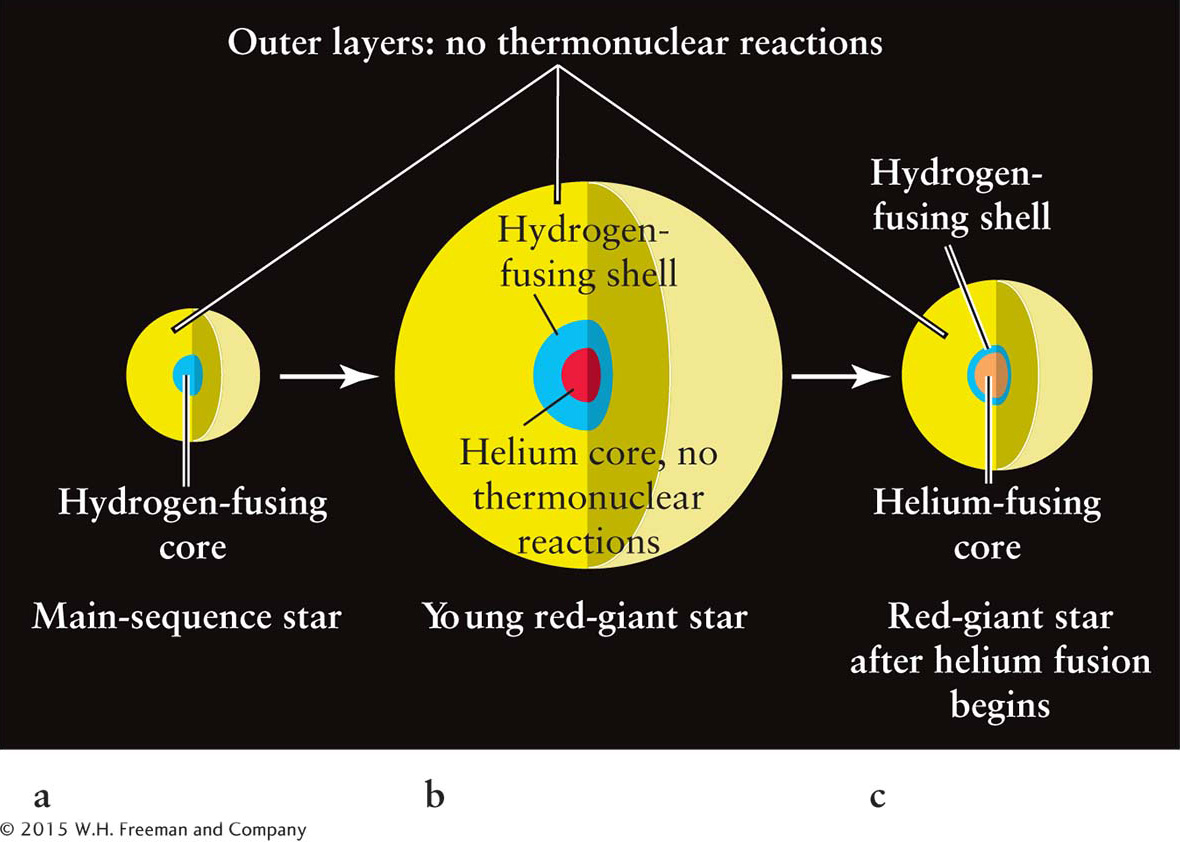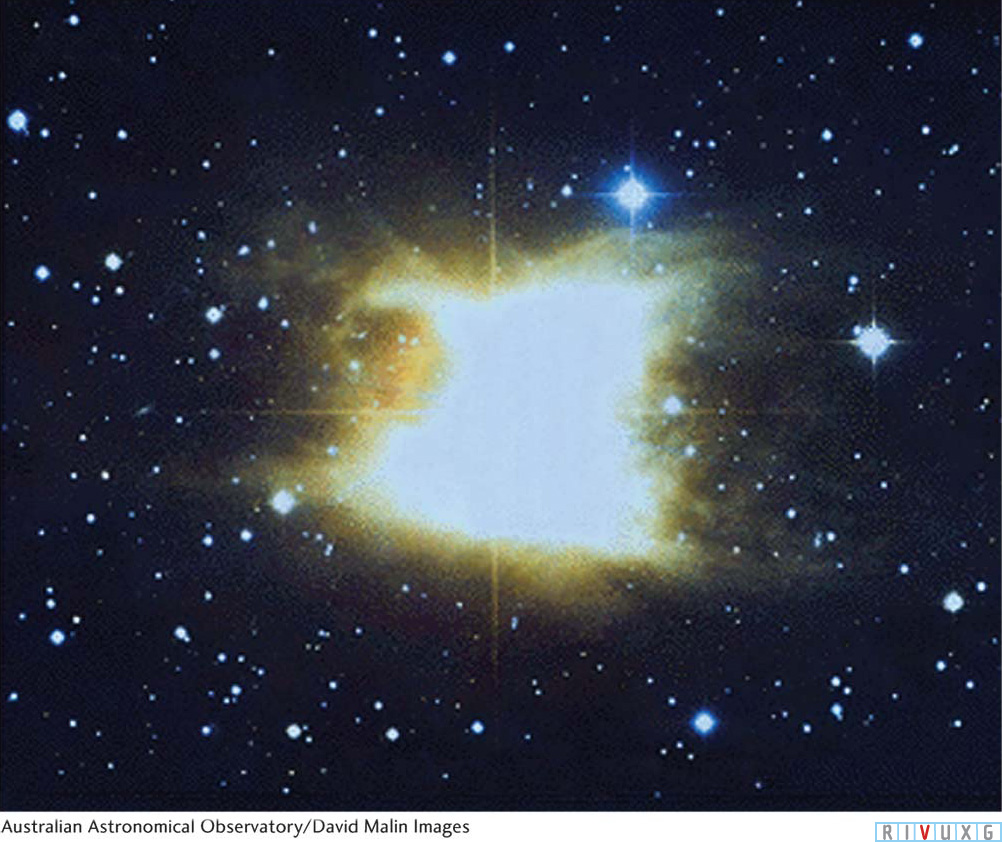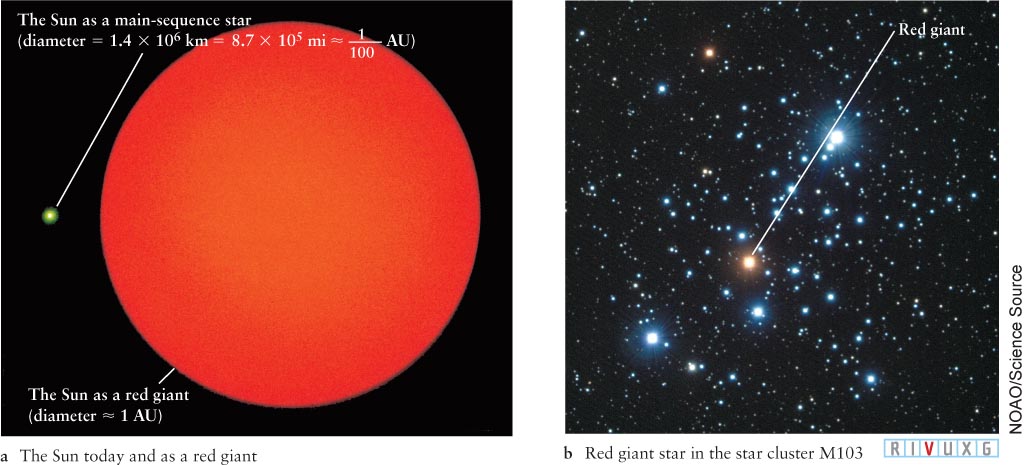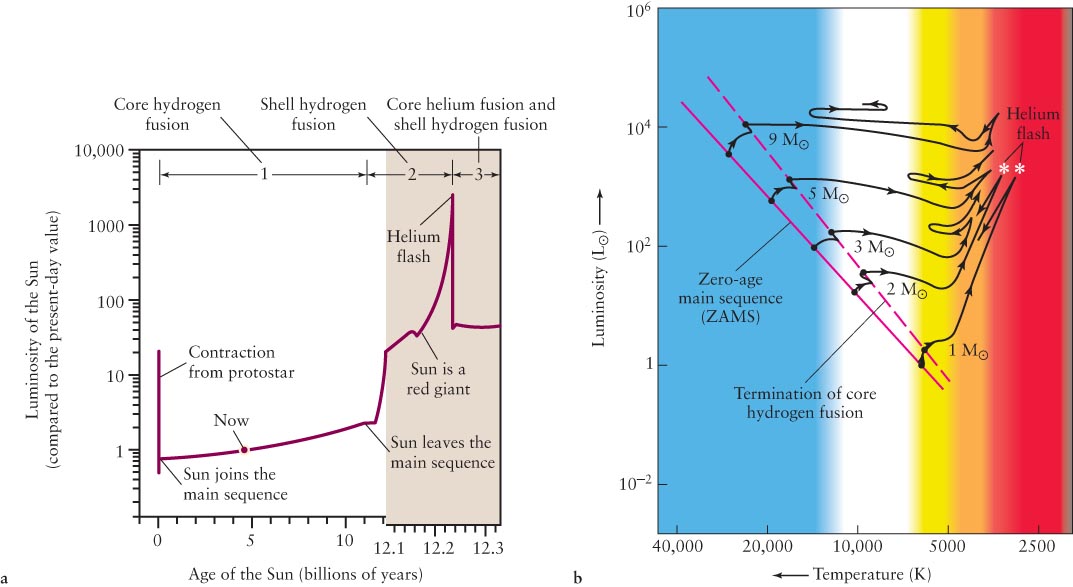EARLY AND MIDDLE EVOLUTION OF INTERMEDIATE (0.4–8 M⊙) AND HIGH-MASS STARS
The changes in stars with more than 0.4 M⊙ are much more complicated. In this chapter, we consider what happens to these stars on the main sequence and in the evolutionary stage after it. In the following chapter, we explore the ends of their lives.
11-9 When core hydrogen fusion slows down, a main-sequence star with mass greater than 0.4 M⊙ becomes a giant
Recall that the main sequence is defined by the fusion of hydrogen into helium in a star’s core. Unlike lower-mass stars, stars with more than 0.4 M⊙ do not transport helium out of their cores by convection. Therefore, the chemical composition of their cores differs from the composition of their outer layers throughout their lives.
When the hydrogen in the core of a main-sequence star with more than 0.4 M⊙ is mostly converted into helium, fusion in the core drastically slows down. The temperature of the core at that time is not high enough to enable its helium to fuse into other elements. However, the star continues to evolve and, contrary to intuition, the end of core hydrogen fusion actually causes these stars to expand in size.
Recall from our discussion of the Sun in Chapter 9 that, while on the main sequence, a star’s outer layers are supported by thermal pressure, the energy for which is supplied by fusion in the core. As the rate of this fusion decreases, a star can no longer support the crushing weight of its outer layers, and so the hydrogen-rich gas just outside the core is compressed inward and thereby heated enough to begin fusing into helium (Figure 11-20). This process is called hydrogen shell fusion because it occurs in a shell a few thousand kilometers thick surrounding the core. Recall from Discovery 9-1: Thermonuclear Fusion that the proton-proton chain is the major source of energy inside the Sun and all other stars fusing H to He in their cores. This fusion process also predominates in hydrogen shell fusion.
Focus Question 11-8
Is the name red dwarf appropriate for the stars so named? Why or why not?

Figure 11-20 Evolution of Stars Off the Main Sequence (a) Hydrogen fusion occurs in the cores of main-sequence stars. (b) When the core is converted into helium, fusion there ceases while the same fusion begins in a shell just outside the core. The star expands into the giant phase. This newly formed helium sinks into the core, which heats up. (c) Eventually, the core reaches 108 K, and core helium fusion begins. This activity causes the core to expand, slowing the hydrogen shell fusion and thereby forcing the outer layers of the star to contract.
 Why, then, does the star expand to become a giant? The photons created in shell fusion are generated closer to the star’s outer layers than are the photons generated in the core. As noted in Section 9-8, photons provide the energy and hence the outward pressure to keep stars in hydrostatic equilibrium. Photons first created in the shell have more energy with which to push the outer layers outward than do photons from the core, which, created closer to the star’s center, have to hold out more of the star’s mass. In other words, the core photons have lost energy by the time they emerge from the core, so they cannot push the outer layers out as much as can shell photons. The outer layers of stars with shell fusion therefore expand farther out (the stars become larger than they were on the main sequence).
Why, then, does the star expand to become a giant? The photons created in shell fusion are generated closer to the star’s outer layers than are the photons generated in the core. As noted in Section 9-8, photons provide the energy and hence the outward pressure to keep stars in hydrostatic equilibrium. Photons first created in the shell have more energy with which to push the outer layers outward than do photons from the core, which, created closer to the star’s center, have to hold out more of the star’s mass. In other words, the core photons have lost energy by the time they emerge from the core, so they cannot push the outer layers out as much as can shell photons. The outer layers of stars with shell fusion therefore expand farther out (the stars become larger than they were on the main sequence).
Far from the fusing shell, the surface gases cool and the temperature of the star’s bloated surface decreases between 3000 and 6000 K, depending on the star’s total mass. In about 5 billion years, our Sun will have a helium core and will swell into a giant with a radius of about ½ AU, vaporizing Mercury and perhaps causing Venus to spiral into the Sun. Earth will be scorched to a cinder.
Giant stars are so enormous that their outer layers constantly leak gases into space. At times, this mass loss is significant (Figure 11-21). When studied spectroscopically, the escaping gases exhibit narrow absorption lines, and the lines from gases coming toward us are slightly blueshifted, due to the Doppler effect. This small shift corresponds to a speed of 10 km/s, typical of the expansion velocities with which gases leave the tenuous outer layers of giants. A typical rate of mass loss for a giant is roughly 10−7 M⊙ per year. For comparison, in a main-sequence star, such as the Sun, mass loss rates are only around 10−14 M⊙ per year.

Figure 11-21  A Mass-Loss Star A red giant star is shedding its outer layers, thereby creating this reflection nebula, labeled IC 2220 and called Toby Jug, located in the constellation Carina. The star is embedded inside the nebula and is not visible in this image.
A Mass-Loss Star A red giant star is shedding its outer layers, thereby creating this reflection nebula, labeled IC 2220 and called Toby Jug, located in the constellation Carina. The star is embedded inside the nebula and is not visible in this image.
Focus Question 11-9
Where in the Sun will the energy be generated to expand it into the giant phase?
Although the surface of a giant is cooler than that of the main-sequence star from which it evolved, the giant is more luminous: It can emit more photons each second because it has so much more surface area. As a full-fledged giant (Figure 11-22a), our Sun will shine 2000 times more brightly than it does today.

Figure 11-22  The Sun Today and as a Giant (a) In about 5 billion years, when the Sun expands to become a giant, its diameter will increase a hundred-fold from what it is now, while its core becomes more compact. Today, the Sun’s energy is produced in a hydrogen-fusing core whose diameter is about 200,000 km. When the Sun becomes a giant, it will draw its energy from a hydrogen-fusing shell that surrounds a compact helium-rich core. The helium core will have a diameter of only 30,000 km. The Sun’s diameter will be about 100 times larger, and it will be about 2000 times more luminous as a giant than it is today. (b) This image shows a red giant star in the cluster M103 in the constellation of Cassiopea.
The Sun Today and as a Giant (a) In about 5 billion years, when the Sun expands to become a giant, its diameter will increase a hundred-fold from what it is now, while its core becomes more compact. Today, the Sun’s energy is produced in a hydrogen-fusing core whose diameter is about 200,000 km. When the Sun becomes a giant, it will draw its energy from a hydrogen-fusing shell that surrounds a compact helium-rich core. The helium core will have a diameter of only 30,000 km. The Sun’s diameter will be about 100 times larger, and it will be about 2000 times more luminous as a giant than it is today. (b) This image shows a red giant star in the cluster M103 in the constellation of Cassiopea.
11-10 Helium fusion begins at the center of a giant
When a star first becomes a giant, its hydrogen-fusing shell surrounds a small, compact core a few times the diameter of Earth, composed of almost pure helium. At first, no thermonuclear reactions occur in the helium-rich core of a giant because the temperature there is too low to fuse helium nuclei. The hydrogen-fusing shell creates more helium, which settles into the core. The eventual transformation of the core follows two dramatically different routes, depending on the star’s total mass. The lower-mass giants, from 0.4 to about 2 solar masses, go down an exceptionally bizarre path.
0.4 M⊙ to 2 M⊙—helium flashThe helium atoms in cores of young giant stars with masses between 0.4 and about 2 M⊙ are squeezed by the gravitational force into a crystal-like solid. At the pressures they are under, these atoms are completely ionized, separating into nuclei and electrons. The electrons, distributed between the nuclei, are so closely crowded together that they come under the influence of a phenomenon called the Pauli exclusion principle, first formulated in 1925 by the Austrian physicist Wolfgang Pauli. According to this principle, nature does not allow two identical particles to exist in the same place at the same time. As the electrons are pressed closer and closer together, the exclusion principle forces many of them to move faster and faster so that they do not become “identical,” here meaning being in the same place and moving with the same speeds as adjacent electrons. This motion creates increased repulsion between adjacent electrons.
Astronomers call the electrons in this situation degenerate. Degeneracy, by keeping electrons apart, provides a pressure in the core and thereby prevents the core from collapsing. Thus, the helium-rich core of a low-mass giant is supported by electron degeneracy pressure. This state provides a greater outward pressure than did the normal pressure in the star before degeneracy developed in its core. The solid core grows from infalling helium and heats up under the gravitational influence of the star’s mass.
Here is the weirdest part. The equations predict that, unlike the pressure of an ordinary gas, the pressure inside a degenerate core does not change with temperature. In a normal gas, like the air we breathe, when the temperature increases, the pressure also increases, causing the gas to expand and cool. When a degenerate core’s temperature increases, the pressure there does not increase. Without the “safety valve” of increasing pressure, the star’s core cannot expand and cool when overheated. Rather it sits there, just getting hotter and hotter.
Eventually, the core temperature reaches about 100 million K, at which time core helium fusion begins (see Figure 11-20c). This fusion creates energy, so the core’s temperature increases. But a degenerate core’s pressure is unable to increase. If the core pressure increased, the core would expand and cool. Because the core does not immediately expand, during the first few hours of core helium fusion, both the core temperature and the fusion rate increase dramatically. This situation is called the helium flash.
When the core temperature reaches around 3.5 × 108 K, the degenerate helium is forced to transform back into an ordinary gas. Suddenly, the usual safety valve operates, namely, that the high temperature increases the core pressure, causing the core to expand and cool, moderating the rate of fusion occurring there within a few hours. The expanding core, in turn, enlarges and cools the hydrogen-fusing shell around it. Fusion in the shell therefore decreases, so the flow of photons from the shell directly to the outer layers of the star drops, causing the outer regions to cool. As they cool, they contract—the star shrinks until it reaches a new hydrostatic equilibrium.
Keep in mind that the helium flash occurs in and acts upon the star’s core. It does not cause a sudden flash in brightness. A 0.4 to 2 M⊙ helium-fusing giant is left smaller, dimmer, and hotter than it was before it began fusing helium. Figure 11-23a shows the expected changing brightness of the Sun when going through this process. Figure 11-23b includes evolutionary tracks of two stars in this mass range as they leave the main sequence, move into the giant phase, go through the helium flash, and begin to settle back down. We will follow their evolution through the rest of the giant phase after briefly exploring how stars with more than 2 M⊙ proceed off the main sequence.

Figure 11-23 Post–Main-Sequence Evolution (a) The luminosity of the Sun changes as our star evolves. It began as a protostar with decreasing luminosity. On the main sequence today, it gradually brightens. Giant-phase evolution occurs more rapidly, with faster and larger changes of luminosity. Note the change in scale of the horizontal axis at 12 billion years. (b) Model-based evolutionary tracks of five stars are shown on this H-R diagram. In the high-mass stars, core helium fusion ignites smoothly where the evolutionary tracks make a sharp turn upward into the giant region of the diagram.
More than 2 M⊙—no helium flashThe pressure created by the gravitational force of a star with more than 2 solar masses is enough to smoothly compress and heat its core until it reaches the fusion temperature of helium. In other words, the cores of giants in this mass range never become degenerate.
Focus Question 11-10
Will the Sun undergo a helium flash? Why or why not?
When an ordinary gas, such as the helium that exists in the cores of these stars, is compressed, it heats up; conversely, when it expands, it cools down. If the energy production created by helium fusion overheats its core, that extra heat provides extra pressure that forces the core to expand, thereby cooling its gases and slowing the rate of thermonuclear reactions. Conversely, if too little energy is being created to support the star’s overlying layers, the star’s gravity pulls them farther inward, thereby compressing the core. The resulting increase in core temperature speeds up the thermonuclear reactions and thus increases the energy output, which stops the contraction. Either way, the “safety valve” keeps it from collapsing or exploding.
Figure 11-23b shows the evolution off the main sequence of three stars in this mass range, which do not undergo helium flash. These stars move up and to the right across the giant region of the H-R diagram, getting larger until core fusion begins, whereupon they contract slightly—less than stars that undergo the helium flash.
11-11 Life in the giant phase has its ups and downs
The dominant process for fusing helium in the cores of giants is called the triple alpha process, in which three helium atoms fuse to become a carbon atom. (Early in the twentieth century, certain particles emitted by radioactive nuclei were called alpha particles. They were later identified as helium nuclei.) The triple alpha process works in two steps. First, two helium nuclei fuse to create beryllium. If within 10−8 s a third helium nucleus collides with the short-lived beryllium, then carbon is formed. Otherwise the beryllium decays back into two helium atoms. This process also releases energy and can be summarized as follows:
4He + 4He + 4He → 12C + γ
where γ (gamma) denotes energy emitted as photons. The fusion in giants does not stop there. Some of the carbon thus created can fuse with another helium nucleus to produce oxygen:
As in main-sequence stars, the energy released in these fusion processes is in the form of gamma rays.
Focus Question 11-11
How many helium atoms does it take to make one oxygen atom?
Giant stars fuse helium in their cores for about 10% as long as they spend fusing hydrogen while on the main sequence. For example, the Sun will spend a total of about 10 billion years on the main sequence, after which it will be a giant for about 1 billion years. While helium fusion is occurring in a giant’s core, further gravitational contraction of the star’s core ceases.
Despite the fact that all stars spend most of their lives on the main sequence, most of the stars visible to the naked eye are giants! This occurs because the relatively few giants in our neighborhood are so luminous that they outshine their neighbors in the night sky.

 Why, then, does the star expand to become a giant? The photons created in shell fusion are generated closer to the star’s outer layers than are the photons generated in the core. As noted in Section 9-
Why, then, does the star expand to become a giant? The photons created in shell fusion are generated closer to the star’s outer layers than are the photons generated in the core. As noted in Section 9-


 A Mas
A Mas